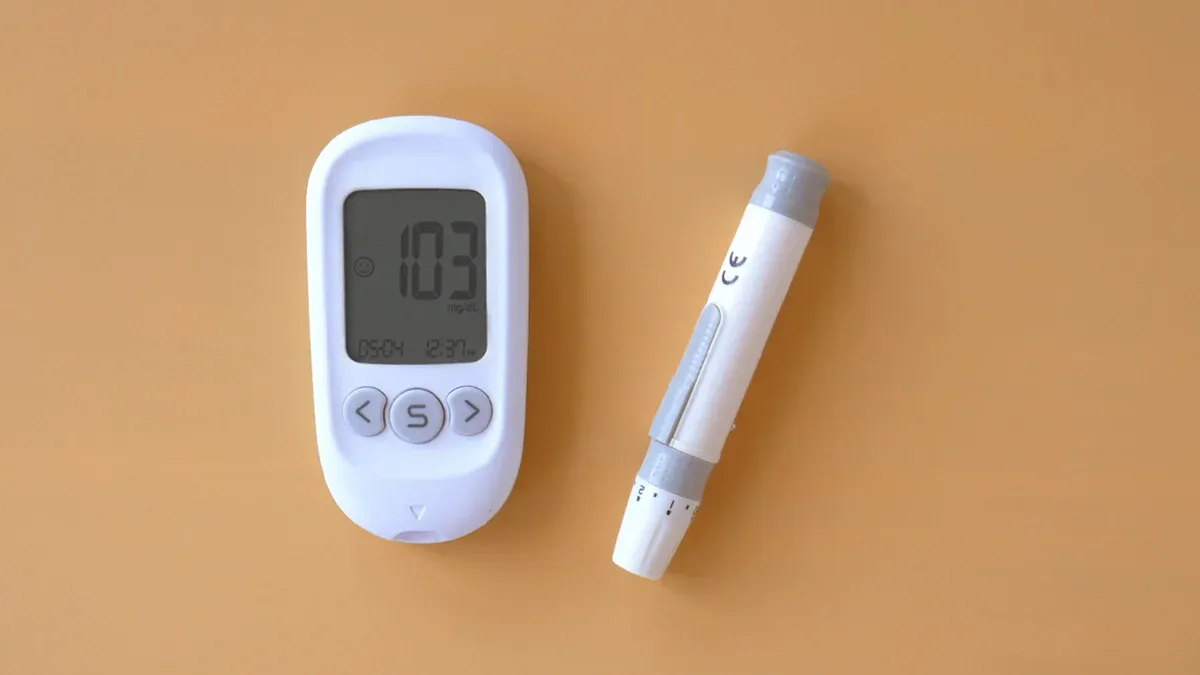
When comparing semaglutide vs tirzepatide, you may wonder which one is more effective for weight loss and blood sugar management. Both medications belong to the GLP-1 receptor agonist class, yet they function differently. Tirzepatide and semaglutide are beneficial for managing diabetes and weight issues. However, it is crucial to understand their side effects and how well individuals tolerate them. Gaining knowledge about semaglutide vs tirzepatide can assist you in making the best decision for your health.
Key Takeaways
Semaglutide and tirzepatide are both medicines that help control blood sugar. Semaglutide works on GLP-1 receptors, while tirzepatide works on GLP-1 and GIP receptors.
Tirzepatide usually helps people lose more weight than semaglutide. Studies show tirzepatide can help people lose about 20.2% of their weight. Semaglutide helps with about 13.7% weight loss.
Both drugs lower blood sugar and improve A1C levels. Tirzepatide works a little better in these areas than semaglutide.
Common side effects of both drugs are feeling sick, throwing up, and diarrhea. Tirzepatide may cause these side effects more often than semaglutide.
Think about your health goals and how you handle side effects when picking between these two drugs. Talk to your doctor to decide what’s best for you.
Both medicines also help lower the chance of heart problems. They can improve your overall health and how your body uses energy.
Start with a small dose of either drug to let your body get used to it. Your doctor will decide the right dose for you.
Visit your doctor regularly to check how you’re doing. They can change your treatment plan if needed.
Mechanisms of Action: Semaglutide vs Tirzepatide
How Semaglutide Works
Semaglutide is part of a group called GLP-1 receptor agonists. It copies the actions of a hormone called GLP-1. When you use semaglutide, it activates GLP-1 receptors in your body. This causes several helpful changes:
It helps your body make more insulin when blood sugar is high.
It lowers glucagon, a hormone that increases blood sugar levels.
It slows how fast food leaves your stomach, keeping you full longer.
It reduces hunger and helps you eat less, leading to weight loss.
Studies show semaglutide helps control blood sugar and supports weight loss. These benefits make it useful for treating type 2 diabetes and obesity.
How Tirzepatide Works
Tirzepatide works in two ways. It targets both GLP-1 and GIP receptors. This double action boosts its effects. Here’s what tirzepatide does:
Like semaglutide, it helps make insulin and lowers glucagon.
It also activates GIP receptors, improving fat breakdown and insulin production.
It reduces hunger and helps burn more energy, causing weight loss.
Research shows tirzepatide acts differently at GLP-1 receptors. It has special signaling features, like producing cAMP in one phase and partly activating arrestin. These unique traits may make it work better.
Key Mechanistic Differences
The main difference between semaglutide and tirzepatide is their targets. Semaglutide works only on GLP-1 receptors. Tirzepatide works on both GLP-1 and GIP receptors. This gives tirzepatide extra benefits for metabolism.
Drug | How It Works | Weight Loss Results |
|---|---|---|
Semaglutide | Activates GLP-1 receptors | Less weight loss than tirzepatide |
Tirzepatide | Activates GLP-1 and GIP receptors | More weight loss at higher doses |
Tirzepatide lowers HbA1c and causes more weight loss than semaglutide. Its ability to target GIP receptors improves fat burning and energy use. Semaglutide is still a good choice for people who don’t need GIP receptor benefits.
Tirzepatide vs Semaglutide: Weight Loss and Health Benefits
Weight Loss Results
Tirzepatide and semaglutide are great for losing weight. Both help people reach their weight goals. But tirzepatide seems to work better for weight loss.
Studies show tirzepatide causes more weight loss than semaglutide.
Research from 2021 to 2024 shows this difference. Higher doses of tirzepatide may explain the better results.
Here’s a table comparing their weight loss results:
Drug | Average Weight Loss (%) | 25% Weight Reduction Achieved (%) |
|---|---|---|
Tirzepatide | 31.0 | |
Semaglutide | 13.7 | 16.1 |
This data shows tirzepatide helps people lose more weight. It’s a good choice for those needing medical help to lose weight. Knowing these differences can guide your decision.
Blood Sugar and A1C Improvements
Both drugs are excellent for type 2 diabetes. They lower blood sugar and improve A1C levels, which measure long-term sugar control. Tirzepatide works slightly better in this area too.
Here’s a table comparing their effects:
Medication | Weight Reduction | % Achieving A1C <7% | % Achieving A1C <5.7% | |
|---|---|---|---|---|
Tirzepatide 5 mg | -2.01% | -7.6 kg | 82.0% | 27.1% |
Tirzepatide 10 mg | -2.24% | -9.3 kg | 85.6% | 39.8% |
Tirzepatide 15 mg | -2.30% | -11.2 kg | 86.2% | 45.7% |
Semaglutide 1 mg | -1.86% | -5.7 kg | 79.0% | 18.9% |
The table shows tirzepatide lowers A1C more and helps more people reach normal sugar levels. If you have type 2 diabetes, tirzepatide might be a better option.
Other Health Benefits
These drugs also offer extra health benefits. They can improve your overall health.
Semaglutide lowers the chance of heart problems by 20%.
Tirzepatide reduces cholesterol, helping heart and metabolism health.
Both improve how your body uses insulin, lowering diabetes risks.
They help control stress and appetite, boosting emotional health.
Semaglutide may also protect kidneys. It lowers the risk of kidney disease by 24%. In a study of 17,600 people with heart disease, semaglutide reduced kidney problems by 22%.
Both drugs may help with liver issues like non-alcoholic fatty liver disease (NAFLD). They reduce liver fat and improve liver health.
If you’re thinking about weight loss treatments, these added benefits make tirzepatide and semaglutide great choices for better health.
Side Effects: Comparing Semaglutide and Tirzepatide
Common Side Effects
Using semaglutide or tirzepatide may cause some side effects. These usually happen as your body gets used to the medicine. The most common side effects include:
Feeling sick (nausea)
Throwing up (vomiting)
Loose stools (diarrhea)
Trouble pooping (constipation)
Stomach pain
Less hunger
These side effects are often mild and go away over time. But sometimes, they can make daily life harder. For example, nausea happens more with tirzepatide (25-28%) than semaglutide (16-20%). Tirzepatide also causes more diarrhea and vomiting.
Side Effect | Semaglutide Rate | Placebo Rate | Tirzepatide Rate | Placebo Rate |
|---|---|---|---|---|
Feeling Sick (Nausea) | 16-20% | 6% | 25-28% | 8% |
Loose Stools (Diarrhea) | 9% | 2% | 19-23% | 8% |
Throwing Up (Vomiting) | 5-9% | 2% | 8-13% | 2% |
Trouble Pooping (Constipation) | 3-5% | 2% | 11-17% | 5% |
Stomach Pain | 6-7% | 5% | 9-10% | 5% |
If you have these side effects, eating different foods or taking the medicine with meals might help. Talk to your doctor if the symptoms don’t go away or get worse.
Severe Side Effects and Risks
Most side effects are mild, but serious ones can happen. These are rare but important to know about. Severe stomach problems, like bad nausea, vomiting, or diarrhea, may occur, especially when doses increase.
Both drugs have a warning about thyroid tumors, including cancer. This risk is based on animal studies. Watch for signs like a neck lump, trouble swallowing, or a hoarse voice that doesn’t go away.
Other serious risks include:
Swelling pancreas (pancreatitis): Signs are strong stomach pain, nausea, and vomiting.
Gallbladder issues: These can cause stomach pain, nausea, and vomiting.
Blocked intestines: Symptoms include a swollen belly, gas, and pain.
If you notice these problems, see a doctor right away. They can check if it’s safe to keep using the medicine.
Tolerability Differences
How well people handle these drugs can differ. Tirzepatide often causes more stomach problems, like nausea and diarrhea, than semaglutide. If you have a sensitive stomach, semaglutide might be better for you.
Still, tirzepatide’s double action on GLP-1 and GIP receptors may give bigger benefits for weight loss and blood sugar control. If you can handle the side effects, tirzepatide might work better for managing diabetes and losing weight.
Choosing between these medicines depends on how you handle side effects, your health goals, and your doctor’s advice.
Dosage and Administration: Semaglutide vs Tirzepatide
Semaglutide Dosage and Maintenance
Semaglutide starts with a small dose to help your body adjust. At first, you take 0.25 to 0.5 mg weekly. This slow increase helps reduce side effects like nausea. After adjusting, you move to the main phase. In this phase, doses range from 1.0 to 2.4 mg weekly, based on your health needs.
During the maintenance phase, your doctor may change the dose. Some people stay at 0.5 mg weekly, while others need up to 2.4 mg. This flexible dosing lets treatment fit your needs.
Phase | Dose | Frequency | Notes |
|---|---|---|---|
Initial Titration | 0.25-0.5 mg | Weekly | Start small to avoid side effects. |
Therapeutic Phase | 1.0-2.4 mg | Weekly | Continue until health goals are met. |
Maintenance Phase | 0.5-2.4 mg | Weekly/Biweekly | Adjust dose based on your response. |
This step-by-step plan helps you get good results while avoiding problems.
Tirzepatide Dosage and Maintenance
Tirzepatide also starts with a low dose that increases over time. The first phase often uses 10 mg weekly to improve weight and blood sugar. Later, your doctor may raise the dose to 15 mg for better results.
Higher doses of tirzepatide lead to more weight loss. For example, people taking 15 mg lost 5.5% more weight than those on 10 mg. Your dose depends on your needs and how well you handle the medicine.
Dosage (mg) | Average Weight Loss (%) | Notes |
|---|---|---|
10 | 21 | First phase weight loss |
15 | Extra 5.5 | Continued weight loss |
Placebo | Regained weight | Comparison group |
This gradual increase helps you get the best results while managing side effects.
Administration Methods Compared
Both semaglutide and tirzepatide are given as shots under the skin. You inject them in areas like your belly, thigh, or upper arm. These shots are usually done once a week, making them easy to use long-term.
Tirzepatide shows slightly better results for lowering blood sugar and weight. For example, a 15 mg dose of tirzepatide lowers HbA1c by 21.61 mmol/mol and weight by 9.57 kg. A 2.0 mg dose of semaglutide lowers HbA1c by 17.74 mmol/mol and weight by 4.97 kg.
Drug | HbA1c Reduction (mmol/mol) | Body Weight Reduction (kg) |
|---|---|---|
Tirzepatide 15 mg | -21.61 | 9.57 |
Tirzepatide 10 mg | -20.19 | 8.00 (approx.) |
Semaglutide 2.0 mg | -17.74 | 4.97 |
Tirzepatide 5 mg | -17.60 | 5.27 |
Semaglutide 1.0 mg | -15.25 | 3.00 (approx.) |
Semaglutide 0.5 mg | -12.00 | 2.52 |
Choosing between these medicines depends on your health goals and how you feel about injections. Talking to your doctor can help you pick the best option for you.
Contraindications and Long-Term Safety
Who Should Not Use Semaglutide?
Some people should not take semaglutide. These include:
Those with a personal or family history of medullary thyroid carcinoma (MTC).
People diagnosed with Multiple Endocrine Neoplasia syndrome type 2 (MEN 2).
Anyone allergic to semaglutide or its ingredients, as it may cause serious reactions like swelling or trouble breathing.
Here’s a table of who should avoid semaglutide:
Who Should Avoid | Why |
|---|---|
History of medullary thyroid carcinoma (MTC) | Higher risk of thyroid tumors |
Diagnosed with MEN 2 | Risk of hormone-related problems |
Allergic to semaglutide | May cause severe allergic reactions |
If you fit into any of these groups, talk to your doctor about other options.
Who Should Not Use Tirzepatide?
Tirzepatide is not for everyone. Avoid it if you have:
A personal or family history of medullary thyroid carcinoma (MTC).
A diagnosis of Multiple Endocrine Neoplasia syndrome type 2 (MEN 2).
Serious stomach or gut problems, as it could make them worse.
A history of unexplained pancreas or gallbladder issues.
Other groups who should avoid tirzepatide include:
Pregnant or breastfeeding people, since its effects are unclear.
Those under 18 or over 75, as there’s not enough safety data.
Anyone allergic to tirzepatide or its ingredients.
If you are in one of these groups, ask your doctor about safer treatments.
Long-Term Safety Information
Both semaglutide and tirzepatide have been tested for long-term safety. Semaglutide has been studied for up to two years in trials like SUSTAIN. These studies show it is safe, with mild stomach-related side effects and a low chance of low blood sugar.
Tirzepatide is newer but has shown good results in long-term studies like SURPASS and SURMOUNT. These trials lasted 40 to 72 weeks and found tirzepatide is safe for most people. Both drugs mainly cause stomach issues, but serious problems are rare.
Research is still ongoing to check their long-term safety. Regular doctor visits can help ensure these treatments stay safe and work well for you.
Choosing Between Semaglutide and Tirzepatide
Things to Think About
When picking between these two medicines, consider a few things. Both help with type 2 diabetes and weight loss, but they work differently. Comparing their results can help you decide:
Outcome | Tirzepatide | Semaglutide |
|---|---|---|
Lost at least 5% body weight | 64.6% | |
Lost at least 10% body weight | 62.1% | 38.0% |
Lost at least 15% body weight | 42.3% | 19.3% |
Weight change at 3 months | -2.3% | N/A |
Weight change at 6 months | -4.3% | N/A |
Weight change at 12 months | -7.2% | N/A |
Stomach-related side effects | Similar | Similar |
This chart shows tirzepatide may help with more weight loss. It’s better for people wanting big changes in weight. Both medicines have similar stomach-related side effects. Your choice depends on your goals, how you handle side effects, and how fast you want results.
Talk to Your Doctor
Before starting any medicine, it’s important to talk to your doctor. They can help you choose the best option for your health. Here’s why this is important:
Doctors check your health history to find the safest choice.
They monitor your blood sugar and side effects to keep you safe.
If you need to switch medicines, they guide you through it safely.
Follow these steps for the best results:
Work with your doctor to make a plan for weight and blood sugar.
Share your goals so your treatment fits your needs.
Have regular check-ups to track progress and adjust your plan.
Note: This blog gives general info and is not medical advice. Always talk to your doctor to make sure your treatment is right for you.
By working with your doctor, you can feel sure your plan fits your needs. This helps lower risks and get the most out of your medicine.
When looking at Semaglutide and Tirzepatide, they work differently and have unique effects. Semaglutide only works on GLP-1 receptors. Tirzepatide works on both GLP-1 and GIP receptors, which boosts its benefits. Tirzepatide often helps more with weight loss and blood sugar, but it can cause more side effects like nausea and diarrhea.
Here’s a simple comparison:
Aspect | Semaglutide | Tirzepatide |
|---|---|---|
How It Works | Targets GLP-1 receptors | Targets GLP-1 and GIP receptors |
Benefits | Helps control blood sugar and lose weight | Better blood sugar and weight loss due to dual action |
Common Side Effects | Nausea, vomiting, diarrhea, constipation | Nausea, vomiting, diarrhea, constipation, skin reactions, allergies |
Serious Risks | Pancreatitis, gallbladder issues, rare cancers | Being studied, possible kidney changes, faster heart rate |
Your decision should match your health goals and how you handle side effects. Talk to your doctor to find the best choice for you. They can help you stay safe and get good results.
FAQ
What makes Semaglutide and Tirzepatide different?
Semaglutide works on GLP-1 receptors only. Tirzepatide works on both GLP-1 and GIP receptors. This makes Tirzepatide better for weight loss and blood sugar control. But it might cause more side effects.
Can people without diabetes use these medications?
Yes, both are approved for weight loss in non-diabetic people. Talk to your doctor to see if they are right for you.
How soon will you see results?
You might notice changes in a few weeks. Full results usually take 3-6 months. Your doctor will check your progress.
Are these medicines safe to use for a long time?
Yes, studies show they are safe for long-term use. Semaglutide has been tested for two years. Tirzepatide has been studied for over a year. Regular doctor visits help ensure safety.
What happens if you miss a dose?
Take the missed dose within 5 days. If it’s been more than 5 days, skip it and stick to your schedule. Never take two doses at once.
Can you stop taking these medications suddenly?
Stopping suddenly can cause weight gain or high blood sugar. Always ask your doctor before stopping. They can help you stop safely if needed.
Do these medicines interact with other drugs?
Yes, they can interact with insulin or diabetes pills. Tell your doctor about all the medicines you take to avoid problems.
Do you need to follow a special diet?
No strict diet is needed, but smaller, balanced meals help. Avoid overeating or fatty foods to reduce nausea.
Tip: Follow your doctor’s advice to stay safe and get the best results with Semaglutide or Tirzepatide.


